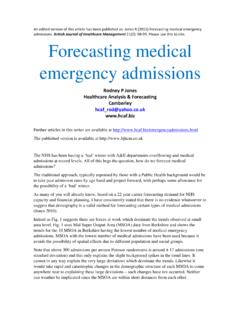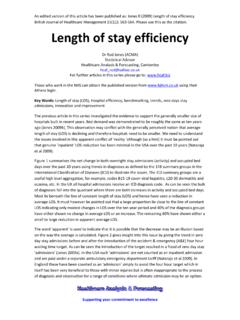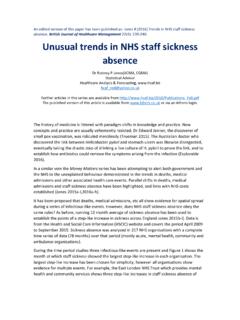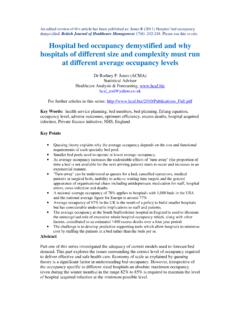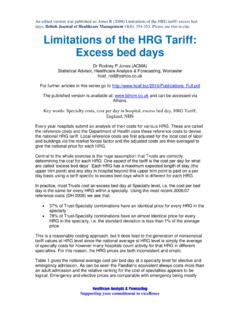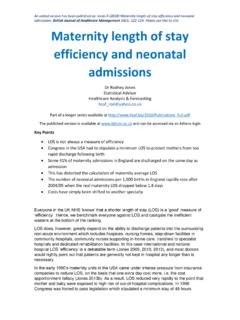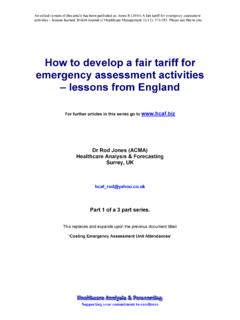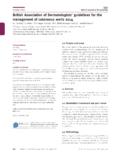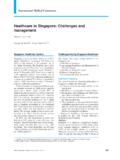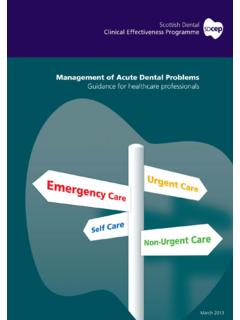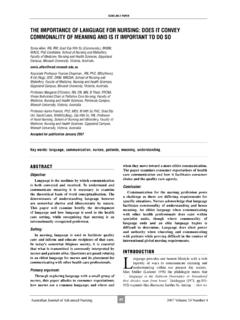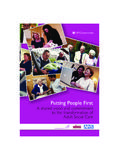Transcription of A series of unexplained infectious events leading to ...
1 An edited version of this article has been published as: Jones R (2015) unexplained infectious events leading to deaths and medical admissions. British Journal of Healthcare Management 21(1): 46-47. Please use this to cite. A series of unexplained infectious events leading to deaths and medical admissions in Belfast Dr Rodney P Jones (ACMA, CGMA) Healthcare Analysis & Forecasting Further articles in this series can be found at The published version of this article is available at or via Athens Our ability to forecast future health care activity and costs relies on our knowledge of the factors responsible for future demand. The rapid increase in medical admissions is a largely unexplained phenomenon which has been attributed to all manner of factors such as the ageing population, breakdown of the nuclear family, elderly living alone, more conservative GP behavior, hospital admission thresholds, medical technology, increasing expectations and the failure to integrate health and social care (Jones 2013a-b, 2014c, 2015b).
2 It has been recently pointed out that emergency medical admissions do not grow as a continuous trend, as would be expected from the above explanations , but tends to grow in distinct spurts which coincides with points at which deaths show an unexplained large increase (Jones 2013a, 2014a-d, 2015a, Jones and Beauchant 2015). Figure 1: Running twelve month total deaths relative to expected in Belfast (1992 to 2013) Monthly data by local government district is from -2%0%2%4%6%8%10%12%Dec-92 Dec-93 Dec-94 Dec-95 Dec-96 Dec-97 Dec-98 Dec-99 Dec-00 Dec-01 Dec-02 Dec-03 Dec-04 Dec-05 Dec-06 Dec-07 Dec-08 Dec-09 Dec-10 Dec-11 Dec-12 Dec-13 Deaths relative to expectedTwelve month period ending atAn edited version of this article has been published as: Jones R (2015) unexplained infectious events leading to deaths and medical admissions.
3 British Journal of Healthcare Management 21(1): 46-47. Please use this to cite. A running twelve month total of deaths in Belfast from 1992 to 2013 is shown in Figure 1 to illustrate these periods of unexplained increase in deaths. On this occasion a second order polynomial curve fit has been applied to the ongoing trend downward in total deaths and the actual deaths relative to this long-term trend are shown in Figure 1. There has never been an adequate explanation for the peaks in death and in the absence of such an explanation they have largely been ignored as one of those things . The peaks in death show distinct spatial spread across the entire UK (Jones 2015a) and in Northern Ireland the 2012 event shows the maximum 12 month difference commencing in August 2011 in Belfast and Larne through to December 2012 in Castlereagh, spread across the whole of Northern Ireland takes around 16 months.
4 Similar slow spatial spread has been observed in all parts of the UK (Jones 2014a-e, Jones and Beauchant 2015). Due to the fact that emergency admissions tend to cluster in the last months of life there is a well-documented relationship between occupied bed days and deaths (Jones 2011). A potential link with the deaths in Figure 1 and medical emergency admissions is therefore explored in Figure 2 where it can be seen that admissions do minded tend to peak around the same time as deaths. As only financial year data is available for admissions the direct linkage can be obscured and recall that in Figure 1 the total deaths is for the 12 month period ending at the particular date. The small peak in admissions 2001/02 arises from a spike in deaths in January and February of 2002 (which is not so obvious in a running 12 month chart), however, the shoulder in admissions in 03/04 and 04/05 matches with a broad peak in deaths between Jul-02 and Oct-04 and the peaks commencing in 2008/09 and 2012/13 are likewise linked to two distinct peaks in deaths.
5 Figure 2: Emergency medical admissions in Belfast (2000/01 to 2013/14) Financial year data for the medical group of specialties kindly provided by DHSSPSNI. It is important to note that the increase in deaths is just the tip of the iceberg in terms of medical admissions. Hence the 2012 event leads to around a step-like increase of around 200 deaths but with a corresponding step-like increases in admissions of 975 (overnight stay admissions) and 965 (same day stay admissions), there are almost 10-times more admissions than extra deaths. Also note that the 1500016000170001800019000200002100022000 Medical group emergency admissionsAdmissions (Excl zero day)AdmissionsAn edited version of this article has been published as: Jones R (2015) unexplained infectious events leading to deaths and medical admissions.
6 British Journal of Healthcare Management 21(1): 46-47. Please use this to cite. deaths tend to decline back to baseline while the impact on admissions tends to be ongoing, although with the start of a decline just before the next event, hence the undulations in the trend. All the evidence is pointing toward a recurring series of infectious outbreaks which are of such a powerful nature as to dominate the trends in deaths, admissions and the trends in age-standardized mortality (Jones 2014b-e, Jones and Golding 2014). It is therefore absolutely no surprise that financial and activity models are proving to be woefully inadequate. Common sense dictates that we identify the infectious agent as quickly as possible and then search for potential vaccines in order to ameliorate the potentially crippling 10% increase in medical costs associated with these outbreaks.
7 Shrugging of shoulders and muttering about one of those things is no longer an acceptable response to a serious public health threat. References Jones R (2011) Does hospital bed demand depend more on death than demography? BJHCM 17(5): 190-197. Jones R (2013a) Could cytomegalovirus be causing widespread outbreaks of chronic poor health? In Hypotheses in Clinical Medicine, pp 37-79, Eds M. Shoja, et al. New York: Nova Science Publishers Inc. Available from: Jones R (2013b) Recurring outbreaks of a subtle condition leading to hospitalization and death. Epidemiology: Open access. 4(3): 137. Jones R (2014a) infectious -like Spread of an Agent leading to Increased Medical Admissions and Deaths in Wigan (England), during 2011 and 2012.
8 Brit J Med Medical Res. 4(28): 4723-4741. Jones R (2014b) A Study of an unexplained and Large Increase in Respiratory Deaths in England and Wales: Is the Pattern of Diagnoses Consistent with the Potential Involvement of Cytomegalovirus? Brit J Med Medical Res. 4(33): 5179-5192. Jones R (2014c) An unexpected increase in adult appendicitis in England (2000/01 to 2012/13): Could cytomegalovirus (CMV) be a risk factor? Brit J Med Medical Res. 5(5), 579 603. Jones R (2014d) infectious -like spread of an agent leading to increased medical hospital admission in the North East Essex area of the East of England. Biomedicine International. 5(1): in press Jones R (2014e) A new type of infectious outbreak? SMU Med J. 2(1): 19-25 Jones R, Goldeck D (2014) Unexpected and unexplained increase in death due to neurological disorders in 2012 in England and Wales: Is cytomegalovirus implicated?
9 Medical Hypotheses 83(1): 25-31 Jones R (2015a) A previously uncharacterized infectious -like event leading to spatial spread of deaths across England and Wales: Characteristics of the most recent event and a time series for past events . Brit J Med Medical Res. 5(11): 1361-1380. Jones R (2015b) Unexpected and disruptive changes in admissions associated with an infectious -like event experienced at a hospital in Berkshire, England around May of 2012. Brit J Med Medical Res. 6(1): 56-76. Jones R, Beauchant S (2015) Spread of a new type of infectious condition across Berkshire in England between June 2011 and March 2013: Effect on medical emergency admissions. Brit J Med Medical Res. 6(1): 126-148.
